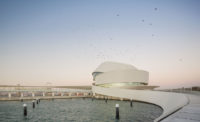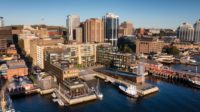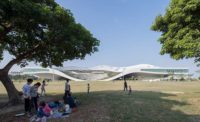Resembling a pod of porpoises frozen in midleap, the Kaohsiung Port Terminal gradually rises into view above a mundane skyline as one approaches from the southern Taiwanese city’s downtown. At the waterfront—a patchwork of parking lots and construction sites, shipping containers and cranes—it’s difficult to tell whether the building is emerging from the sea or from the land. Passing the light-rail stop at street level, one ascends to the automobile drop-off at the main entrance, set on a raised platform that extends almost to the site’s perimeter. Only here does it become clear that the architecture is not a set of discrete overlapping and intertwining objects, like a school of fish or a den of snakes, but rather a single multilimbed (or multiheaded?) creature, its asymmetrical tentacles and snouts all sprouting from the arrival lobby.
This international cruise ship terminal is the second major project in Taiwan by RUR Architecture, the New York–based practice of husband-and-wife team Jesse Reiser and Nanako Umemoto. Incorporating a tower containing administrative offices for Taiwan’s busiest port, the terminal is described as “three-dimensional urbanism” by its architects, who hope this initial node will guide and connect future development along the waterfront. Wrapping around the exterior, the entry platform doubles as a boardwalk with an expansive view of the harbor, as well as a broad canopy for informal street markets. Various elbows and groins contain gardens in arrays of dots and stripes. From certain angles, it all feels somewhat predatory and surreal. Are these vermiform extrusions looming overhead to be understood as blind, snuffling trunks in search of airborne prey? Or, more benignly, a consequence of tropism, the botanical phenomenon that causes plants to twist or grow toward sunlight, nutrients, and moisture?

1
Smooth surfaces line interiors (1 & 2). Photos © Iwan Baan, click to enlarge.

2
While this talk of biology may sound overwrought, it is in many ways relevant—not only to the terminal but also to the architects’ design process more generally. An extraordinary achievement in terms of form, space, structure, and material, the building is an efflorescence of ideas and techniques explored by Reiser and Umemoto over the course of their careers. They admit that the interest in zoomorphism partly originates in their exposure, as students at the Cooper Union in New York, to the figural experiments of longtime dean John Hejduk, in which Reiser detected “a feeling of empathy between building and people, much like the Japanese belief in the latent animism of things that charges objects with a certain vitality.” But the direct precursors in their own work are the trilobed schemes for the Cardiff Bay Opera House competition in 1994 and the Taipei Music Center. At Kaohsiung, the directionality is reversed; rather than three auditoriums oriented toward a shared stage, as in Cardiff, or three buildings organized around a plaza, as in Taipei, here the spaces expand outward and upward from the central lobby.

Rearing cantilevers cover entrances. Photo © Iwan Baan
With fully transparent ends oriented toward the sky, and partly glazed throats allowing views down to the esplanade and the water beyond, the rearing cantilevers are a combination of steel trusses and spaceframes—effectively enormous box girders that more or less smoothly merge with the canted office tower and its diagrid exoskeleton. The aluminum envelope, with gill-like slats and scalelike panels, at first appears to be a thin skin. In fact, it has a varying thickness that conceals not only structural and mechanical elements, but a network of secondary public corridors. This intricate spatial manifold is, according to the architects, inspired by the engines of Ferrari’s Formula One cars, but again reflects Hejduk’s influence—specifically his pedagogical exercise of transforming a musical instrument into a building. The terminal recalls the combination of functional and aesthetic precision that produces both the elegance of a clarinet and the awkwardness of a set of bagpipes. Such biomechanical analogies might suggest that the terminal was parametrically designed, using calculus-based, continuously varying forms. Actually, the sinuous profiles are concatenations of elliptical segments connected at tangent points, painstakingly crafted through hand drawings and models, then later finessed with software.

3
Gill-like openings in the cladding (3) bring light into the terminal, which includes an integrated office tower (4). Photos © Iwan Baan

4
Not everything has gone according to plan, of course. The legal requirements of privacy, security, and fire safety for an international transport facility have necessitated physical and visual barriers—ranging from guide ropes and glazed partitions to solid bulkheads—in places where the architects had hoped for continuity. In some cases, these have been grudgingly integrated with the body of the architecture; in others, they were installed retroactively. Navigating the cavernous interior might be a confusing experience for tired tourists expecting a clearly demarcated sequence of ticketing, immigration, customs, and boarding areas, but it is never difficult and, above all, never dull.

Entry and exit ramps for automobiles echo the curvilinear nature of the terminal’s many limbs.
Photo © Iwan Baan
Though the building was unshaken by the April earthquake in Taiwan’s Hualien County, 125 miles to the northeast, when leaving by sea or by land, one might catch a glimpse of movement in the rearview mirror. The parallax effect seen from a turning or receding vehicle causes a slow, majestic shifting of the silhouette of the Kaohsiung Port Terminal as it seems to come to life.
Click plan to enlarge

Click section to enlarge

Click section to enlarge

Credits
Architect:
RUR Architecture — Jesse Reiser, Nanako Umemoto, principals; Jasmine Lee, Neil Cook, Michael Overby, Kris Hedges, Eleftheria Xanthouli, Juan DeMarco, Massimiliano Orzi, design team; Toshiki Hirano, Sonya Chao, Imaeda Ryosuke, assistants
Architect of Record:
Fei & Cheng Associates
Engineers:
Ysrael A. Seinuk, Supertek (structural); Arup, I.S. Leng, Mininger (m/e/p)
Consultants:
Arup (port planning and logistics); Environmental Arts Design (landscape); Meinhardt Facade Technology (facade); Izumi Okayasu Lighting Design Office, Fomolux (lighting)
General Contractor:
Chun Yuan Construction
Client:
Kaohsiung Harbor Bureau
Size:
397,000 square feet
Cost:
$165 million (construction)
Completion Date:
March 2023





Post a comment to this article
Report Abusive Comment